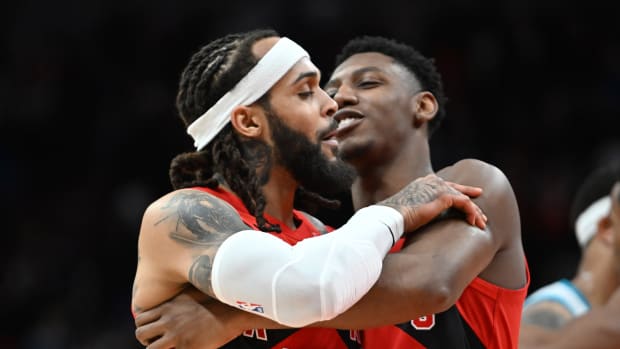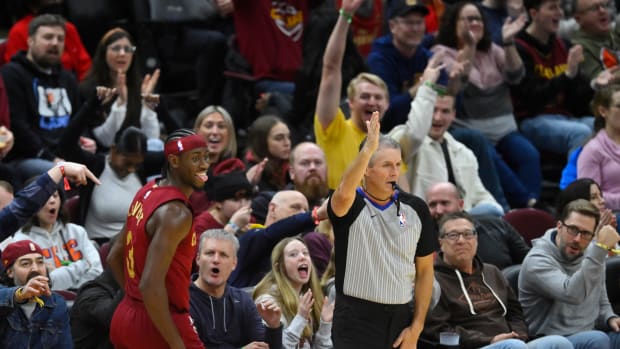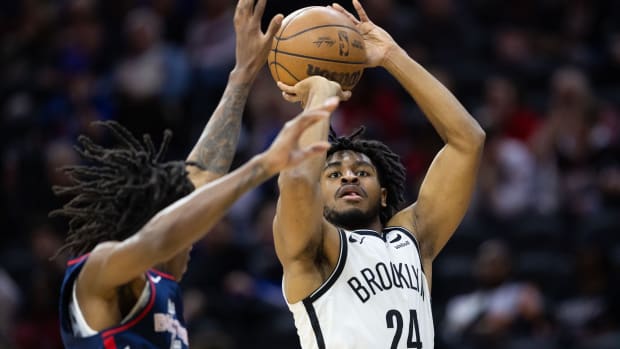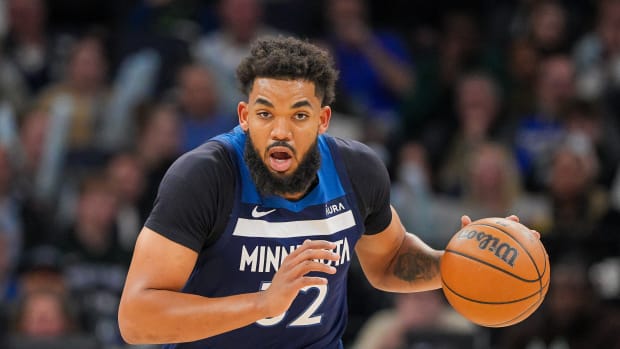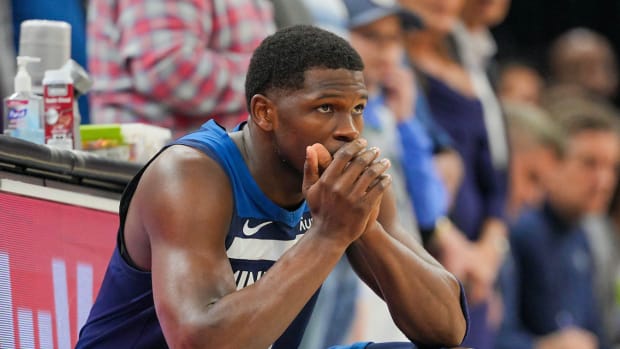Three adjustments the Blazers need to make against the Warriors in Game 3
Get all of Ben Golliver's columns as soon as they’re published. Download the new Sports Illustrated app (iOS or Android) and personalize your experience by following your favorite teams and SI writers.
PORTLAND, Ore. — The Blazers enter Saturday’s Game 3, the latest last stand of a charmed season, battling an infuriating feeling that’s become well-known to Warriors’ opponents: Sometimes a strong and well-executed gameplan still isn’t enough to prevent a double-digit defeat.
Before crumbling down the stretch of Game 2 en route to a 110-99 loss, Portland savored a long taste of a possible upset. Damian Lillard took advantage of soft pick-and-roll coverage to snipe from deep, an absolute necessity that wasn’t there in Game 1. CJ McCollum put his strong in-between game to good use, a useful workaround solution to Golden State’s fierce interior defense. Al-Farouq Aminu and Gerald Henderson both delivered efficient shooting nights in complementary roles, helping the Blazers outshoot the Warriors from beyond the arc. As a team, Portland played with excellent energy from the opening tip and cleaned up its worst defensive miscues from an ugly Game 1, taking away most of Golden State’s transition offense and holding Klay Thompson and Draymond Green to a combined 14-for-40 from the field.
Against most opponents, those would be winning indicators. Against the defending champs, even down Stephen Curry, that was only enough to keep things competitive until the final few minutes. The sting of the Warriors’ late push, one that secured a 2-0 series lead, has lingered for days.
“I was pretty hot about that one,” Lillard told reporters on Thursday. “After the game I was pretty frustrated with not being able to finish that game. [Wednesday] I didn’t even want to see a basketball. I wasn’t even going to watch the playoff game yesterday until I heard Cleveland was hitting a bunch of threes, so I wanted to see for myself. I didn’t even want to have nothing to do with basketball yesterday after that game.”
• MORE NBA:Klay Thompson splashing even more while Curry recovers
Green, Thompson and company seemed to relish in delivering that soul-crushing feeling. If Portland grappled to explain Game 2’s ending, Golden State treated the contest, which saw them erase a 17-point deficit and hold Portland to 12 fourth-quarter points, as another day at the office. Green used a good chunk of his post-game podium session to stump for Festus Ezeli, predicting that Golden State’s backup center was heading for “big money” in summer free agency. Thompson finished his comments by shouting out his brother, L.A. Dodgers outfielder Trayce Thompson, for crushing a deep home run. Coming minutes after Lillard repeatedly said how much “control” he felt the Blazers had through Game 2, the Warriors’ practiced nonchalance made it seem like it had been an illusion.
• MORE NBA: Is Draymond Green the NBA's best all-around player?
When push came to shove, Green shoved, barreled, hounded, flexed and even called timeout for Blazers coach Terry Stotts, while Lillard and company caved in a flurry of rushed shots and turnovers.
Portland therefore is left hoping to duplicate many aspects of the progress it showed in Game 2 while also taking a steelier approach down the stretch. They’ll do so staring down the same do-or-die proposition they faced in Game 3 of the first round against the Clippers, which is a good place to start from a motivational standpoint. After two big losses in L.A., Portland returned home to win the first of four straight thanks to big performances from Lillard and McCollum, a career-high 21 rebounds from center Mason Plumlee, and an effective all-around defensive performance that limited the Clippers to a season-low three three-pointers.
“We’ll have bounce,” Stotts predicted Thursday. “We came back after 0-2 against the Clippers and we came with a lot of energy in Game 3. Having energy, having bounce at the Moda Center with our crowd, that’s the least of our concerns.”
There’s also a level of comfort to be found in Curry’s anticipated absence. While Stotts told reporters that the Blazers were preparing for Game 3 as if the reigning MVP would return to the court after missing the last three games with an MCL sprain, Warriors coach Steve Kerr nixed that notion.
“He did not practice with the team,” Kerr said Thursday. “[So] probably not. … We need to see him in rhythm, cutting, moving, see how he responds the next day as well.”
Kerr then ruled out Curry in a radio interview with The Dan Patrick Show on Friday. For the Blazers to make this a series, it will take more than urgency, strong outside shooting and Curry’s absence, as they learned in Game 2.
With that in mind, here are a few areas of focus for Game 3 as Portland looks to avoid the 3-0 hole of doom.
1. More from the starting guards. Held thoroughly in check by Golden State’s long wings in Game 1, Lillard and McCollum adapted nicely in Game 2. The former found clean looks in second transition and in pick-and-roll situations involving the paint-bound Andrew Bogut while the latter ran to space in transition situations and ducked into soft spots in Golden State’s defense to generate very makeable long twos.
Areas of refinement remain. For Lillard, going to the basket has been a losing proposition: he’s just 5-for-19 in the paint through two games, and his shot chart makes the three-point arc look like a clear dividing line between good and bad.
, but he should be able improve his efficiency by slowing down a bit when he attacks off the dribble and gets into the paint. Many of his mid-range looks have been unnecessarily forced and off-balance given Golden State’s preference for ceding those in-between shots. A little patience should pay dividends. When he does drive full-bore to the hoop, he needs to seek contact at every opportunity in hopes of filling out his scoring numbers from the stripe and putting the Warriors’ bigs into foul trouble.
McCollum seems past due for a breakout night from beyond the arc, as he hit three or more threes 36 times this season and has yet to do so in the playoffs. A hot night from beyond the arc from the Most Improved Player would obviously be a game-changer. Like Lillard, he struggled to finish around the hoop, where his lack of length and above-the-rim finishing ability really stands out. Forcing the issue by going to the hoop seems like a losing play; getting loose on the break for spot-up looks and off-the-dribble forays against defenses that aren’t yet set is a better recipe to get McCollum going.
One last way to get more from Lillard and McCollum: play them more. McCollum played a postseason-high 42 minutes in Game 3 against the Clippers, while Lillard has yet to play more than 41 minutes in the postseason. Given the stakes on Saturday, both should prepare to make the most of short breathers. Kerr leaned on Green for 41 minutes in Game 1, the most he’s played in the playoffs, and that reliance proved to be a central driver of Golden State’s strong fourth quarter. From a minutes standpoint, this is all in time for Portland.
• MORE NBA:Explaining Chris Bosh’s situation | SI’s NBA playoffs coverage
2. Better discipline on Klay Thompson. Playing 40 minutes of attentive defense on Thompson is easier said than done: he moves constantly, he makes great use of an endless (and often well-disguised) series of screens, and he’s really, really grooving (26-for-50 from deep in his last four games) as the lead option in Curry’s absence. Thompson got off to a somewhat slow start in Game 2 and, not coincidentally, Golden State’s attack looked tame. Similarly, when the Warriors finally pulled even and then in front of the Blazers in the fourth it was thanks to back-to-back three-pointers from their All-Star shooting guard.
Those two shots provide great teaching tape for Portland’s coaching staff. On the first, Thompson worked free for a wide open corner three-pointer after Moe Harkless provided unnecessary help defense on a driving Green. Take a look at the picture below: Harkless reaches in to harass the dribble even though Green really has no path to the basket, movement that opens up an easy passing lane to Thompson and plenty of space in the corner.
Harkless has been cross-matched onto Thompson with increasing regularity in this series because his length allows him to contest Thompson’s jumpers far better than McCollum. A major key to contesting shots is being disciplined enough throughout possessions, on or off the ball, to be in position to get a hand up. The reminder to Harkless is simple: Thompson refers to corner threes as “lay-ups” because he shot 44.4 percent from the right corner this season. Anything Green does against multiple defenders is virtually guaranteed to be a lower-efficiency outcome than granting Thompson a clean look from his sweet spot.
Shortly thereafter, Thompson’s go-ahead three resulted from another clear defensive breakdown. Thompson weaves through a series of screens, losing Harkless on the final one as he works back to the right angle. Expecting Harkless to fight through Green to contest the shot is asking too much; Expecting Al-Farouq Aminu to anticipate trouble and provide help isn’t.
Instead, Aminu watches as Shaun Livingston hits Thompson with a pass in rhythm and then he continues watching a Thompson sets his feet and launches an uncontested three-pointer from the right angle. Then he turns around and watches as it predictably swishes through the net. The communication there has to be better; Thompson is too good of a shooter to be granted a clean look that easily in crunch time.
Bottom line: Thompson’s shooting ability is so good and his release is so quick that he can take advantage of even the slightest errors. With the season hanging in the balance, big errors in defending him are unacceptable.
3. Stick with the playmakers in late-game situations. Nothing was really working for Portland down the stretch, as Golden State used its killer interchangeable lineup (Livingston, Thompson, Harris Barnes, Andre Iguodala and Green) to squeeze the life out of Portland’s offense. The Blazers hit five shots and committed five turnovers in the final period, a ratio that neatly explains how devastating the Warriors’ defense can be when they’re operating at maximum effort and focus.
Lakers’ hire of Luke Walton a move L.A. needed to make
The Blazers really found themselves in trouble when its supporting pieces ventured outside their roles. Plumlee, in particular had a rough quarter: he found the ball in his hands late in the shot clock and drove aimlessly to the hoop before shoveling the ball out of bounds, he committed an obvious charge by driving wildly into a set defense from the wing after a pick-and-pop, and he missed all three of his shots, getting blocked twice. Aminu also had a particularly ugly turnover, dribbling from the top of the key to the protected circle, drawing a triple team without a plan, and then throwing the ball into the stands.
On the other hand, Harkless’s final quarter looked worse on paper than it was in reality. While he missed all three of his three-point attempts, all three were clean, makeable looks generated by good drive-and-kick reads by his teammates. Making even one of those three looks during Golden State’s surge could have had momentum-stunting potential.
For Stotts, those shot opportunities present valuable “glass is half full” material for a team that needs it. Even against the Warriors’ best defensive groups in crunch time, the Blazers were able to create quality shots for a player who, while no sharpshooter, is capable of hitting them. Those looks should still be there again in Game 3 for Harkless and Portland’s other auxiliary late-game options.
Perhaps, then, the Blazers will be able to draw confidence from the knowledge that they left points on the table during their quarter of despair.

































